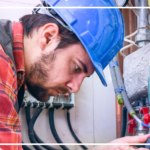Hope Rises in Bristol is offering revolutionary social housing solutions for young people at risk of homelessness by building net-zero carbon homes. These homes were on display at the COP26 to showcase green housing solutions that tackle both the housing crisis and the climate crisis – but could this be a common form of housing in the future?
As part of the COP26 ‘Build Better Now’ virtual reality online exhibition, 11 net-zero carbon homes were being showcased. Currently a small-scale scheme being used to help house young people who are vulnerable to homelessness. The homes are built on stilts above a car park in order to save on space – making the builds more efficient. Each of the houses are fitted with low-energy heating systems, solar panels as well as many other energy efficient technologies that all help to reduce the homes’ carbon emissions.
Speaking to The Big Issue, a director at the architects ZED PODS Dr Rehan Kohdabuccus said “Hope Rise is looking at delivering a zero-carbon lifestyle and to prove that it is affordable for local authorities at social rent levels. “We want to push the boundaries of social cohesion. We want to show that living in a net-zero carbon home is affordable and think about how we use our land.”
The homes were built in conjunction with Bristol Housing Festival in an attempt to prove to local authorities and councils across the country that such an undertaking should be considered for housing development in the future. The homes were manufactured off-site in two modules before being assembled on-site over a period of just five days. This method is not only more beneficial for the environment, but also minimises disruption where the homes are built – a vital aspect when you consider that these homes will primarily be best suited to busier urban areas.
So, could this form of housing be the secret to tackling both the climate crisis and the housing crisis both in the UK and globally? Well, there is no short answer, but this project certainly contributes to the conversation. Elements of these builds can be implemented into all residential properties, but they may not be desirable for all potential buyers. There is potential, however, for these models to be scaled up slightly and could be marketed to first time buyers in years to come as a solution to housing prices in inner city areas. There are already discussions underway to introduce more of these homes to other areas of the country, including plans for a build in Bromley, London.
Although this project is still in it’s earlier stages, there is cause to believe that it could well become much more mainstream in the coming years. So perhaps this is the right time to consider the future of green housing as the focus on living as efficiently as possible increases as the climate clock continues to tick.
If you’d like to discuss the options available to you or learn more about mortgages for green housing, contact one of our advisors at FX Mortgages today.





